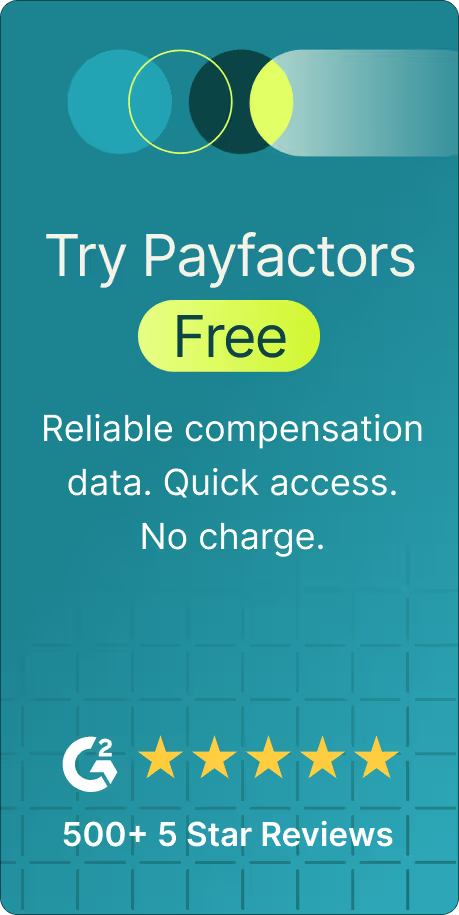Offering a sign-on bonus during salary negotiations is a potentially effective way to convince a highly sought-after candidate to accept a job offer for several reasons. A sign-on bonus provides immediate ficial incentive and negotiation leverage, differentiates one organization from another, demonstrates investment in job candidates, and improves candidate retention.
Read on to learn more about how sign-on bonuses work, the pros and cons of sign-on bonuses, how to offer a sign-on bonus, and more. We'll also explain how Payscale is uniquely situated to help organizations like yours ace employee compensation planning, including sign-on bonuses.
What is a sign-on (or hire-on) bonus?
A sign-on bonus, otherwise known as a hire-on bonus or signing bonus, is a one-time payment or opportunity to invest in an organization's stock that a business offers a potential employee to encourage them to accept a job offer. Typically, employers offer jobs with sign-on bonuses to in-demand candidates who they want to hire. .
Sign-on bonus payments started out as a special form of compensation offered to elite athletes, top software engineers, and other highly sought-after professionals in competitive industries. Recently, more and more businesses across a wider range of industries including fast food chains and warehouses began offering sign-on bonuses with new jobs in response to the labor shortage caused by the COVID-19 pandemic.
Sign-on bonus vs. retention bonus
There are several key differences between different types of bonuses.
A sign-on bonus is a lump sum payment or benefit offered to a prospective employee as an incentive to accept a job. Sign-on bonuses are usually provided by a hiring manager to highly qualified job seekers during the hiring process such as during the job interview or with the salary offer, when the relationship between an employer and employee is just beginning to develop. An organization that offers a sign-on bonus to a desirable candidate is effectively leveraging itself over other organizations that are competing for the same candidate.
A retention bonus is a payment or employee benefit offered to an existing employee as an incentive to stay with the organization for a specific period or until a certain objective is achieved. While a sign-on bonus offer is presented during the hiring process, a retention bonus is typically awarded after a worker commits to a certain period of service within an organization, such as completing their first year or demonstrating stellar performance.
A sign-on bonus is offered to new employees to attract them to the organization, while a retention bonus is offered to existing employees to prevent turnover and maintain organizational loyalty.
How do sign-on bonuses work?
In order to attract and retain top talent, organizations often offer potential new hires a sign-on bonus in the form of a lump-sum cash payment or stock options in addition to their regular compensation package, which typically includes base salary, bonuses, vacation time, and other benefits.
One reason employers offer sign-on bonuses is to compensate new hires for benefits they may be forced to give up by leaving their previous job. Another reason employers turn to sign-on bonuses is that they allow organizations to address shortcomings in the structure of their current compensation packages and meet a potential hire's salary expectations.
Due to differing expectations and talent experience levels among prospective candidates and current employees, sign-on bonuses vary in amount and use. .
Sign-on bonuses are common during high employment rates and labor shortages. They are especially useful for organizations looking to attract candidates weighing several job offers.
Pros and cons of hire-on bonuses for companies
There are both pros and cons of giving sign-on bonuses to employees. Each organization must carefully consider if, when, and how they want to use this as a talent attraction and retention tool.
Pros of sign-on bonuses
- Attract candidates
Highly-skilled employees often receive multiple enticing job offers, making it tough for an organization to stand out among competitors. One way to distinguish your organization is by providing a sign-on bonus that demonstrates your investment and interest in the candidate. - Avoid ongoing budget impact
While offering a competitive salary is compelling for prospective job candidates, it's not always a sound ficial decision for the employer. A sign-on bonus, however, is a one-time expense rather than a long-term commitment. Therefore, a sign-on bonus enables you to differentiate your organization from others without a ficial burden. - Manage overhead costs
A sign-on bonus is a non-recurring payment, meaning that your organization's budget is only affected by it once. By offering a sign-on bonus to a candidate, your organization is able to make the payment, finalize the transaction, and proceed with regular budget planning, all while keeping overhead costs low and enticing talented candidates to join your team.
Cons of sign-on bonuses
- Additional cost
When offering a sign-on bonus to job candidates, remember that your choice results in additional expenses. While a sign-on bonus is a one-time payment, it significantly impacts an overall job offer. If you are hiring multiple new employees simultaneously, the cumulative cost of sign-on bonuses sometimes unnecessarily deplete your organization's existing resources and pose an undue ficial burden. - Negative impact on morale
Disparities in pay and hiring bonuses often result from employees' differing negotiation abilities. If employees engage in conversations about their compensation packages a practice that is fairly common despite employers' attempts to prevent it sign-on bonuses sometimes generate feelings of resentment and discontent. For instance, If one employee who received no ficial incentives discovers that their colleague received a sign-on bonus, that discrepancy often leads to feelings of inequity within the workplace, damaging that employee's trust in their employer. - Unrealistic future expectations
By providing employees with a sign-on bonus, organizations run the risk of instilling unrealistic expectations for the future in candidates. In other words, a prospective hiree who receives a sign-on bonus may assume they are entitled to similar bonuses. Creating false expectations is dangerous for organizations because it sometimes leads to disappointment and negatively impacts organizational morale.
How much are sign-on bonuses on average?
Sign-on bonus amounts may vary depending on the business, the candidate, the market, and the overall economy. For managers and executives, the average sign-on bonus lands somewhere between $10,000 and $50,000 or more. Sign-on bonuses of less than $5,000 are more common for individual contributors and technical workers.
For example, the Los Angeles Police Department (LAPD) now offers new candidates a $15,000 sign-on bonus. Amazon offers new shipping employees a $1,000 sign-on bonus and an additional $100 if they get the COVID-19 vaccination. While some hiring bonuses are a fixed dollar amount, others are a percentage of the candidate's salary.
These job sectors offer the highest number of sign-on bonuses, as well as the percentage of job postings offering them:
- Nursing (18.1 percent)
- Driving (15.1 percent)
- Dental (14.7 percent)
- Veterinary (13.5 percent)
- Medical Technician (12.6 percent)
- Physicians and Surgeons (11.4 percent)
- Childcare (11.3 percent)
- Home Health (11.3 percent)
Should your organization offer sign-on bonuses?
When assessing whether to offer or not sign-on bonuses, it's important to consider several key factors:
Industry
Consider the hiring dynamics of your sector. In some cases, there may be an abundance of candidates for available positions, making a sign-on bonus unnecessary. However, if other organizations in your industry are offering a sign-on bonus, consider following suit to remain competitive.
Budgets
Take into account your budget constraints before offering a sign-on bonus. Remember to evaluate your current overhead, assess your ficial capacity to compensate employees, and determine if offering a sign-on bonus is ficially feasible.
Vacancies
Think about the number of vacancies in your organization and the challenges you face in recruiting employees to fill those positions. If your organization has no difficulty in filling open positions, a sign-on bonus is out of the question.
Other incentives
Offering a sign-on bonus is just one way to recruit skilled candidates. That's to say, there are other options out there. Has your organization considered additional vacation time or better health insurance? Think about which benefit option makes the most sense for your organization.
Bonus structure
When structuring a sign-on bonus, be sure to protect your organization's interests by setting a feasible payment amount and timeline and considering the timing of the incentive. By evaluating your organization's specific needs, you can optimize your bonus structure for hiring success.
How to give sign-on bonuses
Once you understand the potential benefits of a sign-on bonus and decide to implement one for your organization, the next step is to provide the bonus. But before doing so, some preparation is necessary.
Follow these four steps to decide on and give sign-on bonuses effectively.
- Determine the bonus amount
Before disclosing the sign-on bonus to potential candidates, determine the specific amount that your organization is prepared to offer. There's a wide range of possible amounts out there, so be sure to consider what your organization is able to afford, whether the position is in high demand, and whether you choose to offer the bonus to all candidates, among other things. - Define terms and conditions
To avoid the risk of paying out a substantial signing bonus only to have the employee quit shortly after, it is crucial to establish terms and conditions that protect your business's ficial stability. For example, consider requiring the employee to complete a provisional period before awarding the sign-on bonus. - Withhold sign-on bonus tax before giving it
Sign-on bonuses, like all bonuses, are subject to taxes that your organization withholds before giving an employee their bonus. This includes federal income tax, state and local income tax (if applicable), and Social Security and Medicare taxes.
When it comes to federal income tax withholding, bonuses are considered supplemental wages. That means your organization is able to either 1) withhold a flat supplemental tax rate or 2) combine the bonus with the employee's wages and withhold taxes based on the combined amount using IRS income tax withholding tables.
To ensure the employee receives the full promised bonus amount after taxes, perform a tax gross-up by increasing the total gross compensation. - Give the bonus to the employee
Once the employee is hired, it's time to provide the sign-on bonus. Simply deliver the bonus to the employee per the terms and conditions you defined beforehand. To do so, ensure that payroll is run at the appropriate time and the bonus is delivered through the correct channel (direct deposit, for example).
Master employee compensation planning with Payscale
Fair and efficient compensation policies are crucial for attracting and retaining top talent. They ensure employees feel valued, increase job satisfaction, and reduce turnover. Compensation planning is the best way to determine these policies because it provides organizations with a strategic framework to align compensation practices with organizational goals and values, ultimately boosting organizational success.
With Payscale, compensation planning is easy. We offer comprehensive software that provides users with uninterrupted access to up-to-date salary data reflecting market changes and allows users to assess employee performance to aid with merit-based salary adjustments. Our AI-powered tools and templates also facilitate the analysis of how salary increases affect budgeting and pay equity. With Payscale's compensation software, your organization will nail compensation planning in no time.





.avif)
